8.17 American Favorite Part II
– Comments on Early Development of the K+E Mannheim Rules
A couple of years have passed since I last wrote about finding an early Keuffel and Esser “Favorite” slide rule and its possible relationship to other slide rules known as the “American”. I have learned more since then about these early rules, as have other collectors, and I have found yet another example that is akin to a previously documented American slide rule. Furthermore, as of this writing, a new example is being sold on eBay with a high asking price which reveals that it is time for an update on the subject.
8.17.1 What is an “American” K&E slide rule?
On the Rareties page on the Oughtred Society web site is a slide rule called the “Keuffel & Esser ‘American’”. The details sub-page for the item provides a comment by its owner, Clark McCoy:
“This rule does not appear in the catalogs. It is theorized that this was the first slide rule actually produced by K&E in the USA. It is very similar to the later model # 4054. The only thing that identifies this rule is the name on the case.”
While on the oughtred.org site, a quick literature search reveals an article from 2001 by Conrad Schure. In the article,46 a slide rule is presented that has
“… no model number or serial number, only the number 44 stamped into the one end of the frame and the end of the slide. This slide rule takes its name from the gold letters stamped into the black morocco-covered cardboard slipcase … In describing one of these rules, which he had for sale on eBay, Wayne Feely has hypothesized that this particular slide rule derived its designation as the”American”, because it was the first slide rule that K&E actually made themselves. … the date of May 28, 1903, has been very neatly lettered in black drawing ink, but this date is written over something that has been scraped off (perhaps a previous and earlier date?)”
Other than both being Mannheim type slide rules made by K&E, a few major things that the two slide rules have in common are (1) neither have any model number, (2) neither appears in any K&E catalog, and (3) they both came in cases labeled as “American”. An example of such a case is shown here, from the McCoy web site:

However, the McCoy and Schure slide rules have distinctly different labeling of their scales. The first type is, as McCoy described it above, essentially what would become the earliest version of K&E’s Model 4054:

For comparison is the slide rule discussed in The Early American Favorite:

The second American slide rule type, presented by Schure in his article in 2001, is also a Mannheim but has a distinct, dense layout of the printed numerals on the scales:

Another Type 2, shown below, is from the Clay Castleberry collection. The image is again from Clark McCoy’s web site, and shows a more complete picture of the rule than was available in the Schure article. This slide rule has been dubbed an “American” because of its similarity to the Schure specimen; however, the Castleberry slide rule did not arrive with a case, and so one does not know if its original case had the word “American” on it.

Over the past couple of decades or more, both the Type 1 and Type 2 rules above have been referred to as “American” slide rules, as neither one is described in any of the K&E catalogs of the late 1800s/early 1900s, and examples of both have been found within American cases. The McCoy and Castleberry specimens shown above are made of boxwood; the material of the Schure slide rule is not specified in the article.
8.17.2 A New Type 2 Example
The slide rule described in my earlier vignette is similar to the Type 1 shown above, but with a few slight differences that were highlighted in that story. And while similar in most respects, mine did not arrive in an American case. Rather, it came in a Favorite case, though the artwork was similar to the artwork found on the American case. Since the time when that article was written I have come across a rule of the second type, which came to me from northern Ohio. The new Type 2 slide rule is shown below:
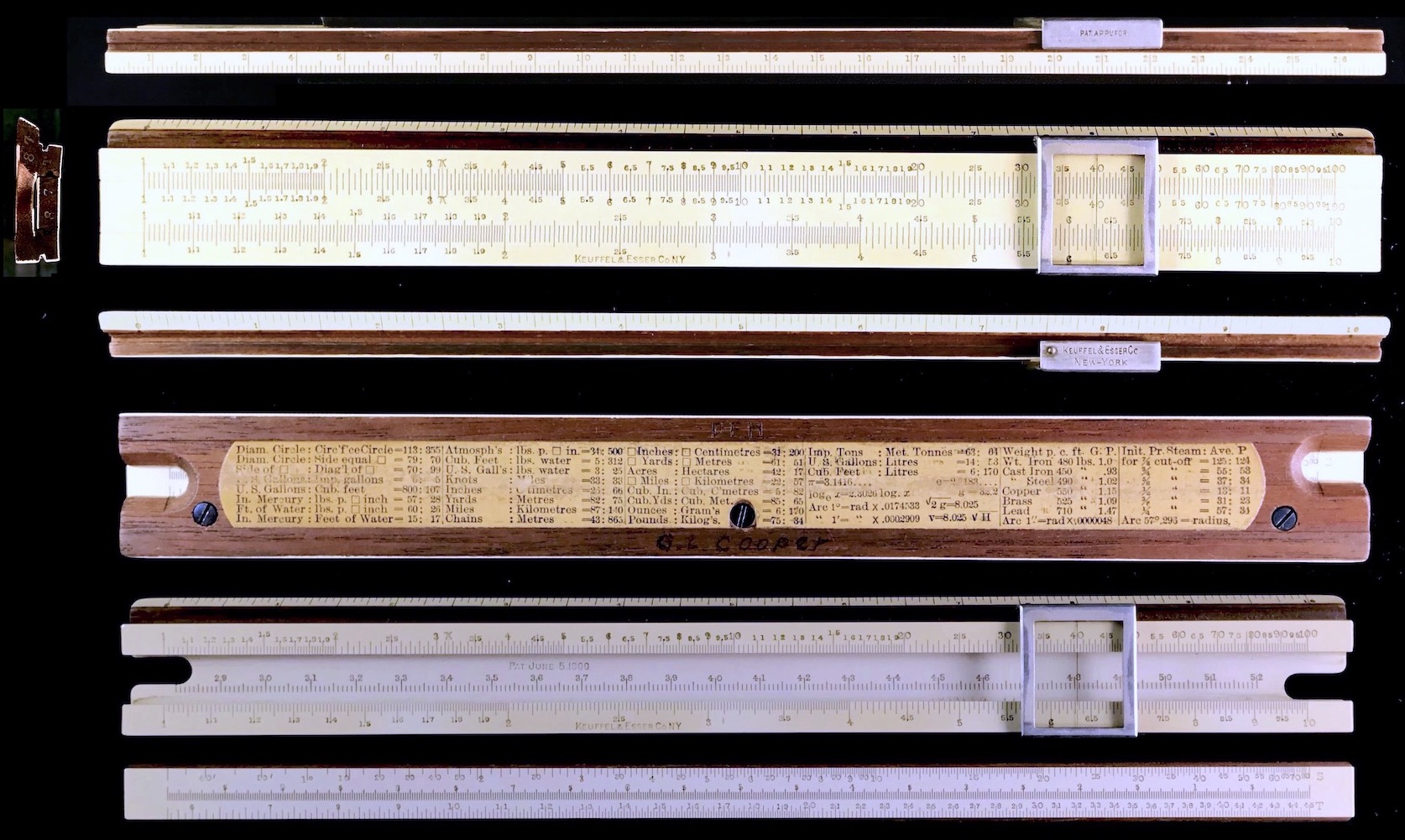
The densely labeled numerals on all the scales are immediately noticeable. Other important features are the patent of 1900, found in the well of the slide rule along with the screws on the bottom of the stock, and the use of mahogany rather than boxwood. From my rather imprecise measurements of their images, the Schure/Castleberry specimens appear to be about 2 mm wider than my Type 2 (32 rather than 30 mm).
So, let’s review. The American in the McCoy collection came with an American case. The American written up by Schure also came with an American case. However, the Castleberry American rule did not come with a case at all; it has been dubbed “American” because it is the same as the Schure rule. The slide rule I recently found is essentially the same as these last two rules, with the exceptions that (a) mine is likely later than Castleberry’s in that mine is made of mahogany and has the 1900 patent, and (2) mine came with a Mannheim case.
But, interestingly, the artwork on this Mannheim case is the same as the artwork on the American case which is the same as the artwork on my Early American Favorite case. At first, the artwork is hard to see, as the case of the new slide rule is quite dirty and faded. But when photographed in better lighting conditions, and with the contrast turned up in post-processing, the artwork I am referring to is easily observed (marked in red), as seen in the following image:

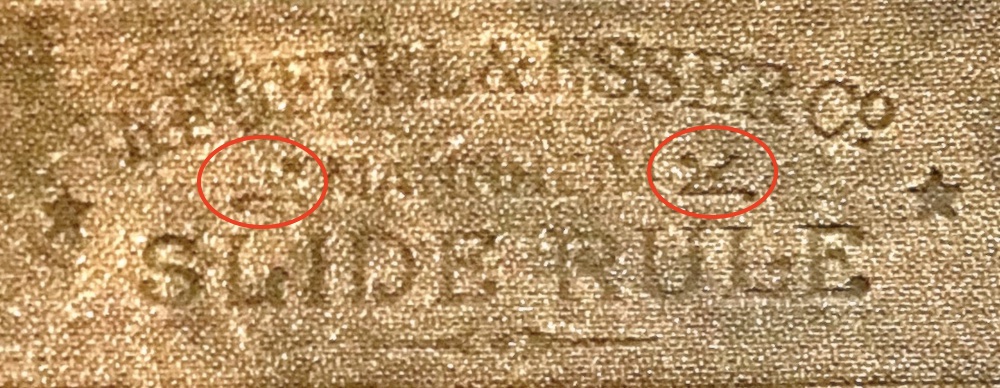
Case labeled Mannheim containing the Type 2 K&E in the collection.
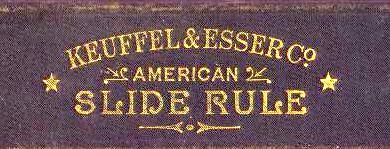
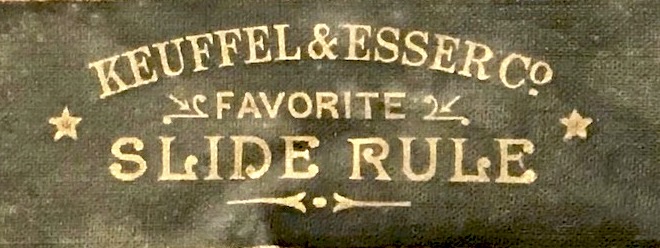
Case artwork for the American (McCoy; cropped from earlier image) and Early American Favorite (Syphers) rules.
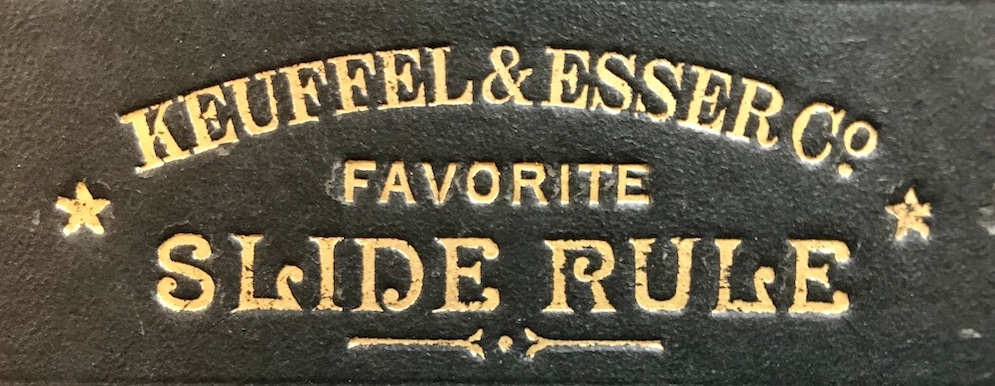
Case artwork for an early Model 4054 Favorite.
For comparison, the American case of McCoy and the Favorite case from my earlier rule are shown as well. Also shown is the Favorite case that came with an early Model 4054 in the Collection; notice the slight change in artwork – the symbols surrounding the Favorite text are missing.
8.17.3 The Tarantolo Collection
Just as the above writing was itself “going to press”, an interesting article was being distributed in the latest version of the Journal of the Oughtred Society. In the article,47 Paul Tarantolo presents a newly found slide rule relevant to our story. The slide rule is clearly a prototype K&E Mannheim from the late 1890s or so. It is made from a combination of boxwood and mahogany, and it has adjustment screws. However, it has four screws on the back of the rule, rather than the usual three, which appear to be prototypical in nature. It also has numerals, perhaps hand-written, in a pattern similar to that found on the Type 2 American rules. The article – highly recommended – goes into many details, but the important connections to our present story is that his slide rule is quite evidently a prototype of K&E’s Mannheim line; K&E was simultaneously (a) playing with both boxwood and mahogany, (b) experimenting with adjustment screw layouts, and (c) examining possible scale and gauge mark labeling scenarios.
After communicating directly with Paul, I learned a great deal more about my two early K&E slide rules. One curiosity that was solved is in regards to the dense numbering on my newly acquired Mannheim rule. Paul had written another article in 2011 in which he describes an “option” that K&E offered to customers in the early 20th century to provide “sub-numbering” on the scales of their slide rules.48 The option is described in the early catalogs of K&E, wording for which is reproduced here from the 1903 catalog:
“… We prefer not to number the subdivisions throughout as is done on some of the printed rules. The sub-numbers are not required by the adept, they are confusing and interfere with rapid and accurate reading. Should they be required for any special purpose, we will put them on without extra charge.”
Thus, my new acquisition was actually an early 4041 Mannheim for which the sub-numbering option was chosen. Paul noted to me that the sub-numbering found on his prototype slide rule with 4 alignment screws was indeed “hand scratched into the celluloid after the slide rule was manufactured.”
It turns out that I have cited other slide rules collected by Paul in past writings, but until now I had not totally appreciated the dedicated work he had done with the hundreds of K&E slide rules he has collected, sorted, researched, and documented. The Paul Tarantolo Collection web page is maintained by the Oughtred Society. From Paul’s collection of about 600 K&E slide rules, he has been able to verify essentially all variants of the array of models and styles of K&E slide rules produced. Images of each variant are shown in detail and illustrate the development of the models over time. From his site I was able to find an example of my so-called “American Favorite” slide rule; it is indeed an early 4054 Favorite, very similar to and derived from what had been called the American. Having “Keuffel & Esser Co. NY” on the left-hand side of the slide dates this rule to about 1903. To find these rules, enter the Tarantolo Collection web page, click on “Toggle Index”, and click on “K&E Favorites”.
8.17.4 Comparison of Early Mannheims
To better view the complexity of the situation in c. 1900, and to help look for any patterns that might emerge, I had begun a compilation of information gathered from my collection and from others that have either shared their collection information with me, or that I could find online. Only items for which I could get “most” of the information for the table were being included, and I had already acquired a list of about 16 slide rules. However, the information I just recently discovered on Tarantolo’s web site has shown me that the work I was beginning to attempt had already been performed. A sincere “Thank You” to Paul, as this must have been a daunting task! As one will see immediately, there is a large number of sometimes subtle variations along model lines which I was attempting to flush out, but that had already been carefully documented. With the understanding that the dense numbering of my second rule is a K&E “option”, and after carefully perusing the Tarantolo web site, I was able to sort the slide rules I had been studying and interlace them with those in the Tarantolo Collection according to his documented variants. All rules could be identified as variants already cataloged by Paul.
The resulting table, in the image below, shows the known American slide rules, and also includes a few examples of the 4054 Favorite, as the American clearly led to this model, and examples of the 4041 – the final high-quality mahogany Mannheim introduced in about 1900.
And also included in the table is an American slide rule that is currently being offered on eBay. This rule is quoted as being the “FIRST EVER KEUFFEL & ESSER AMERICAN SLIDE RULE, ONE OF A KIND, NUMBERED - RARE!!” and comes with an exorbitant price tag. Though I have doubts about this claim,49 it is nonetheless a very fine example of a slide rule found in an American case, hard to come by and well documented photographically, and thus I have included it here.
Cells of the table that are left blank indicate that the information is not known to me, in that the information was not provided to me, or the photograph accessible to me did not show the edge of the rule for example, and so on. If a feature in the table definitely does not exist for a particular rule (does not have a case, or a cursor, etc.), then an “X” is shown.
pdf of the table below
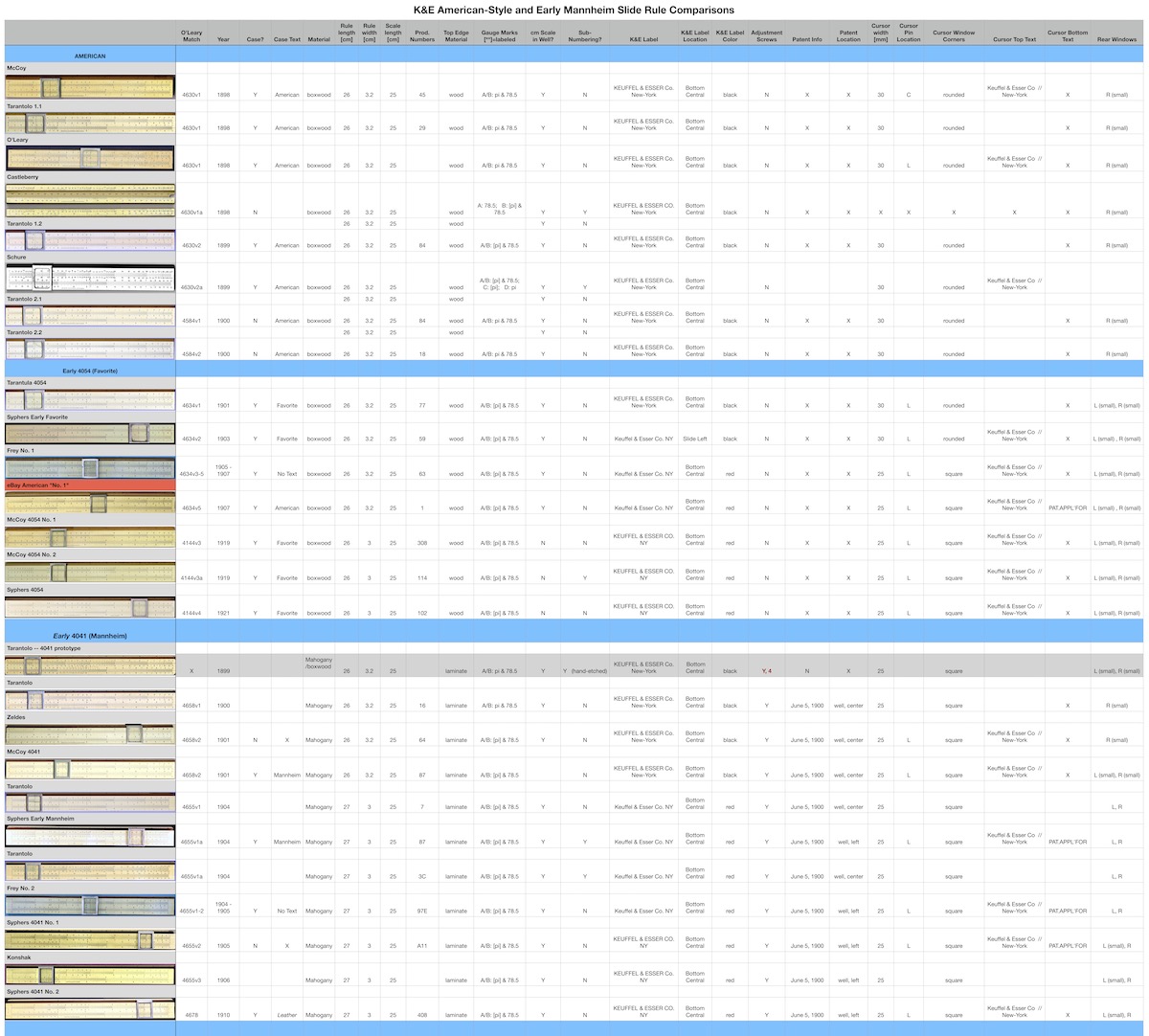
It is clear now that the slide rules that some of us have been calling “Type 1” and “Type 2” American slide rules are actually the same type of rule, but one has the sub-numbering option while the other does not. To be clear, Tarantolo has identified four distinct types of American slide rules. Using the nomenclature he has adopted, they are:
- Match 4630 – Variant #1 (c. 1898): no \(\pi\) gauge mark label
- Match 4630 – Variant #2 (c. 1899): \(\pi\) gauge mark label
- Match 4584 – Variant #1 (c. 1900): no \(\pi\) gauge mark label; no patent notation in slide well; 3 adjustment screws
- Match 4584 – Variant #2 (c. 1900): no \(\pi\) gauge mark label; “PAT.APPD FOR” in the slide well; 3 adjustment screws
If an item were to have sub-numbering, then its Variant number would have an “a” after it (“Variant #1a” or “Variant #2a”, etc.).
The “Match” number is from a system introduced by collector Michael O’Leary to identify similar model styles in the K&E line, which Tarantolo has further differentiated using specimens from his collection. As examples, the McCoy American is a Match 4630 Variant #1, the Castleberry American is a sub-numbered Match 4630 Variant #1a, while the Schure American is a sub-numbered Match 4630 Variant #2a.
The slide rules in the table above with American cases
- were made of boxwood.
- were 26 cm long, 32 mm wide.
- had cursors that were 30 mm wide, with rounded inside edges.
- This is not true for the eBay example, which has a 25 mm cursor with square inside edges, and has “PAT APPL’FOR” on the bottom, indicating a later date. Of course it is always possible that this was a replacement cursor.
- This is not true for the eBay example, which has a 25 mm cursor with square inside edges, and has “PAT APPL’FOR” on the bottom, indicating a later date. Of course it is always possible that this was a replacement cursor.
- had a variety, or perhaps an evolution, of gauge marks and labels. Variants include
- 78.5 and pi (both unlabeled) on A/B
- 78.5 (unlabeled) and pi (labeled) on A/B
- 78.5 (unlabeled) and pi (labeled) on A/B, and pi (labeled) on C/D
- 78.5 (unlabeled) on A/B and pi (labeled) on B
- 78.5 and pi (both unlabeled) on A/B
- had small rear windows on right-hand side for viewing S and L scales.
- The eBay example also has a small window on the left-hand side.
- The eBay example also has a small window on the left-hand side.
- either
- did not have adjustment screws, or
- had adjustment screws but no mention of a patent, or
- had adjustment screws and had “PAT.APPD FOR” in the well.
- did not have adjustment screws, or
From the entries in the complete table, we can see that the K&E company label changed from
- KEUFFEL & ESSER Co. NEW-YORK, used from 1898 to about 1903, then to
- Keuffel & Esser Co. N.Y.,50 from about 1903 to about 1906-1907, and then to
- KEUFFEL & ESSER Co. N.Y. (all smaller font), from about 1906-1907 for several decades.
Notice how the early rules had 25 cm logarithmic scales on a 26 cm slide rule, leaving only 5 mm from the index of a scale to the end of the rule. This would mean that when the hairline of the 30 mm cursor is on the index, the cursor would overhang by 10 mm. Hence these rules could be found with dual-hairline cursors. A 25 mm cursor would help, but would still overhang by 7.5 mm. In about 1904, the length of the slide rules was changed to 27 cm to help further compensate for this situation. With their (center) hairline on the index, the end of the new cursor on the longer slide rule would overhang by only 2.5 mm.
Another aspect to notice is the development of the “rear windows” on the rule. In the beginning there was one small rear window on the right-hand side to view/set the S and L scales, common among all the American rules. The T scale could not be viewed or set. Then, around 1901 or so, a small left-hand side window appeared on which the T scale could be viewed/set. This is found on all of the early Favorite rules. The earliest 4041 rules had only the right-side window, but soon had both left and right windows by 1901. Then, around 1904, the windows had a longer extent for a couple of years or so. Finally, in 1905, the right-side window was longer and wider, allowing all three scales – S, L, T – to be read, but a small window on the left side remained. I believe that this window simply made it easier to initiate movement of the slide to the right using one’s thumb, a feature that users must have gotten used to from having the original left-side T window.
The 4054 Favorite was discontinued in 1927. However, a new model designated 4054 was created in 1944 that was a subset of the Model 4053. It included both the CI and K scales, but did not have measurement scales on its edges. This newer 4054 Polyphase Mannheim was sold until 1952. The 4041 Mannheim line was officially introduced in the K&E catalog of 1901, and was shown in the K&E catalogs for 42 years.
As for the eBay so-called “American” rule, this is an interesting specimen. It is interesting mostly because it is shown with an American case. However, from comparing it with the Tarantolo Collection, the eBay offer appears to be a 4054 Favorite, Match 4634 – Variant #5, from about 1907. In particular, it has “NY” rather than “New York”, it has \(\pi\) labels on A/B, it has rounded edges on the rear table, and the text “Gram’s” in the table, a left-hand rear window for viewing/setting the T scale, and it has “PAT.APPL’FOR” on the bottom edge of the cursor. It is a fine example of an early K&E, but it is clearly later than the other American examples. The big question is, did it originate in the American case? If not, what did?
And as for my recent Mannheim slide rule, it coincides with Tarantolo’s Model 4041 Match 4655 Variant #1a of 1904, an early 27 cm K&E densely sub-numbered Mannheim.
8.17.5 Summary
There was obviously a lot going on in the late 1890s as Keuffel and Esser wrangled with their new slide rule production process and the development of their slide rule line-up. It was very important to them to produce a winning Mannheim line of slide rules, and they no doubt were trying different styles of wood, different scale fonts, labeling, gauge marks, and so on, looking for just the right combination which would make them stand out and be most appealing. It could be possible that some versions were made with boxwood, then with mahogany, then perhaps again with boxwood, and so on. It has been pointed out by Jay Ballauer that the choice of wood may have been driven by availability, that variants were made with both boxwood and mahogony, depending upon what was readily available to K&E at the time.51 He also gives a nice description of boxwood vs. mahogany pointing out how mahogany would be a better choice for the slide rules as it is stronger and more robust in the manufacturing process.
By 1890, and with just a few local exceptions52, all slide rules were being produced in either the United Kingdom, France, or Germany. The Mannheim type slide rules for technical work predominantly being sold in America were from Germany, having been brought in by Keuffel and Esser, Kolesch, Dietzgen, and others. So it was important for K&E to emphasize to their customers that they were now producing their own slide rules in the USA. The American brand on the early K&E slide rule cases was a way to emphasize to buyers that they were doing just that. But when it became apparent that the company was moving toward more than one version of a Mannheim-style slide rule, how do you call one the “American” and any others not “American”? Clearly K&E had their favorite model developed in boxwood, but their goal was to create a fine mahogany rule. Hence, it looks as if the Favorite brand was used for the high-quality rules using boxwood stock initially developed as the American, while their new higher-end mahogany rule for their discriminating customers would become known simply as the Mannheim.
As for my own slide rules, this most recent study has revealed the following:
My “Type 1” slide rule in the Favorite case turned out to be a 4054 Favorite, Match 4634 – Variant #2, from c. 1903.
My “Type 2” slide rule in the Mannheim case turned out to be a 4041 Mannheim, Match 4655 – Variant #1a, from c.1904, in which a sub-numbering option was chosen.
And the eBay “FIRST EVER” American rule appears to be a 4054 Favorite Match 4634 – Variant #5, from c. 1907, albeit the first of its production batch! The fact that it does have an American case, however, cannot be overlooked.
A new company would likely want to sell its prototypes and variants, if they are fully functional, to recoup some of the costs, and to get feedback on the new slide rules from users. As K&E was seasoning its new mahogany in preparation for its new line – a multi-year process – prototypes and test models would have been manufactured in boxwood, or perhaps sparingly in mahogany. As boxwood had been used in European production of slide rules for K&E but the mahogany production was a new process, it was prudent for K&E to continue development of both wood types. Their “Favorite” line might have been the ultimate boxwood rule, but mahogany was their final goal. Dense labeling was found to be too distracting, leading K&E to offer it as an “option” and moving them toward the final labeling we are now familiar with for its mahogany Mannheim – the Model 4041 family.
“If history and science have taught us anything, it is that passion and desire are not the same as truth.” – E. O. WILSON
Special thanks go to those who have communicated and contributed to this report and to the above table of slide rules, particularly Paul Tarantolo, Clark McCoy, Michael Frey, Michael Konshak and the ISRM, and Nathan Zeldes.

Conrad Schure, “The Keuffel and Esser ‘American Slide Rule’”, Jour. Oughtred Soc. 10.2 p9 (2001).↩︎
Paul J. Tarantolo Jr., “Prototype K&E Patent Adjustable Mannheim Slide Rule”, Jour. Oughtred Soc. 32.2 p26 (2023).↩︎
Paul J. Tarantolo Jr., “Sub-Numbering on Keuffel & Esser Slide Rules”, Jour. Oughtred Soc. 20.1 p51 (2011).↩︎
The claim of being K&E’s first slide rule comes from the fact that there is a “1” printed on the stock and slide of the rule. However, these so-called “production numbers” are re-used from batch to batch during the production process. So it would be hard to tell if it is the first rule in the first batch, or the first rule in some subsequent batch.↩︎
The text on the rule is actually “all caps”, but the initials are typeset in a larger font.↩︎
See the nice discussion by Jay Ballauer, “All About Keuffel & Esser Rules”, at his web site: https://www.allaboutastro.com/all-about-ke-rules.html; search for “Sidebar: Mahogany vs. Boxwood”.↩︎
Exceptions would include a few carpenter’s rules, for example by Belcher Bros. in New York, Stanley in Connecticut, and others.↩︎